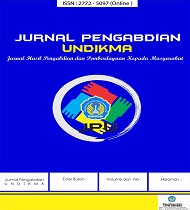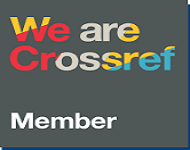Student’s Perception of Instructor’s Emotional Intelligence and Student Performance during Online Learning at the Public University in Malaysia: An Correlational Study
DOI:
https://doi.org/10.33394/jk.v8i2.5172Keywords:
Student’s Perception, Instructor, Emotional Intelligence, Student Performance, Online Learning.Abstract
References
Akbari, R., & Tavassoli, K. (2011). Teacher efficacy, burnout, teaching style, and emotional intelligence: Possible relationships and differences. Iranian Journal of Applied Linguistics, 14(2), 31-61. Retrieved from http://www.sid.ir/EN/VEWSSID/J_pdf/87-620110202.pdf
Allen, I. E., & Seaman, J. (2013). Changing course: Ten years of tracking online education in the United States. Newburyport, MA: Pearson.
Annand, D. (2011). Social presence within the community of inquiry framework. International Review of Research in Open and Distance Learning, 12(5), 40-56. Retrieved from http://www.irrodl.org/index.php/irrodl/article/view/924/1889
Bell, B. S., & Federman, J. E. (2013). E-learning in postsecondary education. The Future of Children, 23, 165-185. Retrieved from http://files.eric.ed.gov/fulltext/EJ1015213.pdf
Brown , J. L .M.(2012). Online learning: A comparison of web-based and land-based courses. Quarterly Review of Distance Education, 13(1), 39-42. Retrieved from http://www.infoagepub.com/quarterly-review-of-distance-education.html
Browning, M. C. (2010). Enhancing online instructional strategies through the utilization of emotional intelligence tools. Proceedings of the ASBBS Annual Conference, 17(1), 400-403. Retrieved from http://asbbs.org/files/2010/ASBBS2010v1/PDF/B/Browning.pdf
Capdeferro, N., & Romero, M. (2012). Are online learners frustrated with collaborative learning experiences? The International Review of Research in Open and Distance Learning, 13(2), 26-44. Retrieved from http://files.eric.ed.gov/fulltext/EJ983271.pdf
Dillman, D. A., Smyth, J. D., and Christian, L. M. (2014). Internet, phone, mail, and mixed-mode surveys: The tailored design method. (4th ed.). Hoboken, NJ: John Wiley and Sons.
Ferrando, M., Prieto, M., Almeida, L., Ferrandiz, C., Bermejo, R., Lopez-Pina, J., Fernandez, M. (2011). Trait emotional intelligence and academic performance: Controlling for the effects of IQ, personality, and self-concept. Journal of Psychoeducational Assessment, 29, 150-159. http://dx.doi.org/10.1- 177/0734282910374707
Gignac, G. E. (2010a). Genos Emotional Intelligence Inventory: Technical manual (2nd Ed.). Sydney, Australia: Genos.
Gorsky, P., & Blau, I. (2009). Online teaching effectiveness: A tale of two instructors. The International Review of Research in Open and Distance Learning, 10(3), 1- 27. Retrieved from http://www.irrodl.org/index.php/irrodl/article/view/712/1270
Hurley, J. & Johnston, J. (2014). Emotional intelligence: Models in educational settings. In J. Hurley, P. Linsley, & R. Zwan, (Eds.), Emotions in educational settings (pp. 12-23). Brisbane, Queensland: Oxford Global Press.
Huh, S., Jin, J. J., Lee, K. J., & Yoo, S. (2010). Differential effects of student characteristics on performance: Online vis-a-vis off-line accounting courses. Academy of Educational Leadership Journal, 14, 81-89. Retrieved from http://aariansyah.files.wordpress.com/2010/12/6.pdf
Kanapathipillai, K., & Narayanan, S. (2021). The relationship between online learning and students performance in the rural areas in Malaysia - the mediating role of parents support. European Journal of Education Studies, 8(11).
Jegathesan, R., Noryati, A., Amar Hisham, J., & Wan Nordiana, W. H. (2018). Learners’ Satisfaction and Academic Performance in Open and Distance Learning (ODL) Universities in Malaysia. Global Business and Management Research: An International Journal, 10(3).
Jennings, P. A., & Greenberg, M. T. (2009). The prosocial classroom: Instructor social and emotional competence in relation to student and classroom outcomes. Review of Educational Research, 79, 491-525. http://dx.doi.org/10.3102/003- 4654308325693
Rocca, K. A. (2010). Student participation in the college classroom: An extended multidisciplinary literature review. Communication Education, 59, 185-213. http://dx.doi.org/10.1080/03634520903505936
Sai, G. T. B., & Lin, A. L. W. (2011). Emotional intelligence of distance learners at the school of distance education, Universiti Sains Malaysia. Malaysian Journal of Distance Education, 13(2), 33-48. Retrieved from http://mjde.usm.my/vol13_2_20-11/mjde13_2_4.pdf
Simonson, M., Schlosser, C., & Orellana, A. (2011). Distance education research: A review of the literature. Journal of Computing in Higher Education, 23, 124-142. http://dx.doi.org/10.1007/s12528-011-9045-8
Tanyel, F., & Griffin J. (2014). A ten-year comparison of outcomes and persistence rates in online versus face-to-face courses. Retrieved from http://www.westga.edu/b-quest/2014/onlinecourses2014.pdf
Vesely, A. K., Saklofske, D. H., & Nordstokke, D. W. (2014). EI training and pre-service teacher wellbeing. Personality and Individual Differences, 65, 81-85. http://dx.doi.org/10.1016/j.paid.20-14.01.052
Wilson, D., & Allen, D. (2011). Success rates of online versus traditional college students. Research in Higher Education Journal, 14, 1-9. Retrieved from http://www.aabri.c-om/manuscripts/11761.pdf
Winters, C. (2011). Emotional intelligence and teaching. Proceedings Mid-West Philosophy of Education Society 2004-2005. Retrieved from http://www.academia.edu/351060/Emo-tional_Intelligence_a-nd_Teaching
Yusof, R., Ishak, N. M., Radzi, A. M., & Pertiwi, E. (2015). Emotional intelligence as predictor of academic achievement among gifted and talented learners in Malaysia. International Journal of Interdisciplinary Social Science Studies, 1(1), 15-23
Downloads
Published
How to Cite
Issue
Section
Citation Check
License
License and Publishing Agreement
In submitting the manuscript to the journal, the authors certify that:
- They are authorized by their co-authors to enter into these arrangements.
- The work described has not been formally published before, except in the form of an abstract or as part of a published lecture, review, thesis, or overlay journal.
- That it is not under consideration for publication elsewhere,
- That its publication has been approved by all the author(s) and by the responsible authorities tacitly or explicitly of the institutes where the work has been carried out.
- They secure the right to reproduce any material that has already been published or copyrighted elsewhere.
- They agree to the following license and publishing agreement.
Copyright
Authors who publish with JK agree to the following terms:
- Authors retain copyright and grant the journal right of first publication with the work simultaneously licensed under a Creative Commons Attribution License (CC BY-SA 4.0) that allows others to share the work with an acknowledgment of the work's authorship and initial publication in this journal.
- Authors are able to enter into separate, additional contractual arrangements for the non-exclusive distribution of the journal's published version of the work (e.g., post it to an institutional repository or publish it in a book), with an acknowledgment of its initial publication in this journal.
- Authors are permitted and encouraged to post their work online (e.g., in institutional repositories or on their website) prior to and during the submission process, as it can lead to productive exchanges, as well as earlier and greater citation of published work.
Licensing for Data Publication
-
Open Data Commons Attribution License, http://www.opendatacommons.org/licenses/by/1.0/ (default)

This work is licensed under a Creative Commons Attribution-ShareAlike 4.0 International License.







